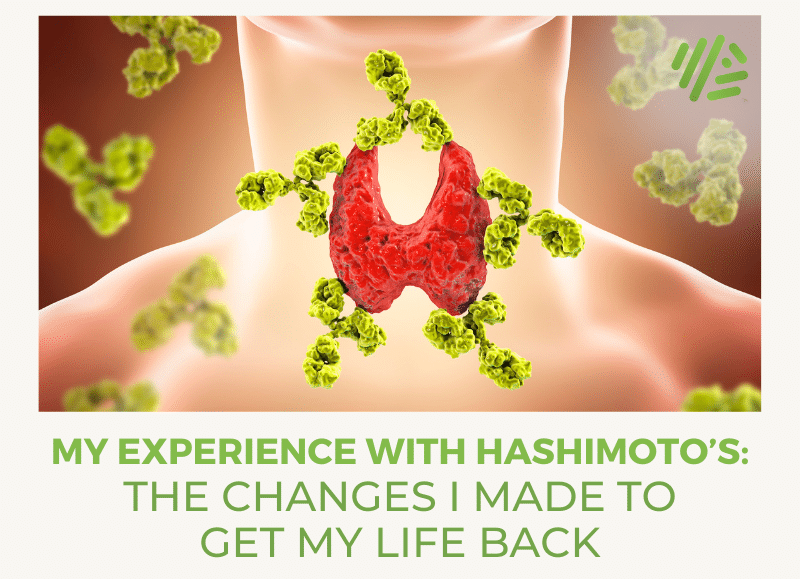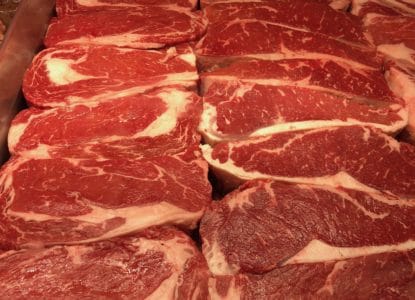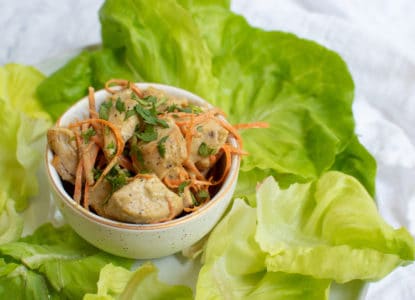My Experience With Hashimoto’s: The Changes I Made to Get My Life Back

Contents
A note for the reader: Hashimoto’s is a complex autoimmune disease, that affects millions. The purpose of this post is not to recommend a protocol for treating Hashimoto’s, but to highlight a Gene Food team member’s first-hand experience with this condition with the hope that it can inspire others to take action to improve their health.
For a Hashimoto’s overview, see this page from the American Thyroid Association.
After my second son was born, I was dead tired. All. The. Time. And achy. And irritable. And did I mention tired? Not too strange for a breastfeeding mom of an infant and a toddler. So, as most of us do too often, I pushed it all aside and continued on with my day-to-day. I figured it was all just “new mommy stuff” and it would pass once I was done breastfeeding.
Why am I so tired?
The Cleveland Clinic’s dedicated Hashimoto’s page lists fatigue as their first symptom.
Fast forward to a year later. I was done breastfeeding and things hadn’t gotten better. In fact, they had only gotten worse. My fatigue was at an all time high. My joints constantly felt like they were on fire. Often, I found myself having trouble concentrating and forgetting important things. And despite a healthy diet and regular yoga practice, I had hit a plateau in weight loss. I started to suspect this was something more than motherhood. So I started where any normal person does now-a-days — Google. With such a vague and intangible set of symptoms, Google was a dead end.
Joint Pain, Vitamin D, and TSH Tests
Since I experienced a lot of joint pain during pregnancy, I was regularly seeing an osteopathic doctor for adjustments. When I described these concerns to her, she decided we needed to run some tests. She had a feeling my Vitamin D and B12 were low, which is common in breastfeeding mothers. Lucky for me, she also threw a TSH test in there for good measure. The test results came back and just as she thought, my Vitamin D and B12 were both very low. But that wasn’t what alarmed her. The huge red flag was my TSH levels. It was skyrocketing. TSH is the messenger that tells your thyroid to produce more thyroid hormone (T4) and mine was sending a clear message — “we don’t have enough!!” She suggested I get more testing and go see an endocrinologist as soon as possible.
Diagnosing Hashimoto’s
Note: according to the NIH, autoimmune disease is on the rise in the United States.
The following week, I found myself in an endocrinologist’s office to go over my tests and set a course of action. I am an action-oriented, do-it-myself person. I am also stubborn as can be and truly believe I can fix anything with enough discipline. So, armed with my nutrition education and motivation to get better, I was ready to work with my endocrinologist to fix whatever was going on with my thyroid. I had already done my reading on pregnancy-induced hypothyroidism and convinced that was the culprit.
The doctor walked in hurriedly and without much polite talk, she told me I had an autoimmune disease called Hashimoto’s. She said my TSH was the highest she’d ever seen and my antibody count indicated that my hypothyroidism was not due to pregnancy, but rather it was due to my autoimmune system mistakenly attacking my thyroid cells. This was producing inflammation in my thyroid, resulting in the cascading symptoms I was experiencing.
I panicked. Up until this point, I had been lucky enough to never deal with a “real” health issue. She told me it was a huge risk for me to not take my medication, gave me a prescription for Levothyroxine, and headed for the door. No questions about my diet or lifestyle. No inquiry into my mental well being. No alternative treatment options. Just “take this pill twice a day for the rest of your life.” Even when I pushed for a nutrition discussion, I was met with “just take the pill and you’ll be fine.” I was shocked. I knew this wasn’t the place for me. I left feeling defeated and completely overwhelmed.
My plan of attack – the approach I used to combat thyroid problems
I went home to my husband and we talked about finding a doctor that shared my passion for holistic medicine. After a lot of research, I found an integrative medical center that focused on a whole person approach and made an appointment for the next month. In the meantime, I filled the prescription and began taking the medication. I was desperate to feel better. It made a difference, but not in a good way. Almost immediately, I had heart flutters and anxiety that didn’t dissipate with time.
Finally, it was time for my appointment. My first visit with them lasted over two hours, with a lengthy discussion with a healthcare provider, a Registered Dietitian, and a chiropractor. They conducted a myriad of diagnostic tests to see what else was feeding this disease. They patiently explained Hashimoto’s and answered all my questions. I finally let out the breath I had been holding since my first visit with the endocrinologist.
Note: we take a science fist approach at Gene Food. There are now studies indicating changes to diet can help inflammation associated with Hashimoto’s. Gina Jones, registered dietitian and Gene Food contributor detailed some of this research in her piece on the AIP diet.
Once my testing came back, my doctor and I went over a step by step plan with the ultimate goal to be off of medication for good. The first course of action was evaluating my diet. As a Nutritionist, I felt confident I was making healthy decisions. And on paper, I was. Until you put that paper up against my food sensitivity tests. Many of the “healthy choices” I was making were not healthy for me. That morning scramble with spinach and mushrooms was a huge trigger. My histamine levels were high and DAO low. I also had food sensitivities to spinach and mushrooms. So essentially my healthy breakfast was starting my day off with big dose of inflammation. This strengthened my belief that healthy is not a one-size-fits-all thing. What is healthy for one person might not be for another. Which is why GeneFood’s nutrition plans make so much sense to me.
Gluten free and dairy free diets for Hashimoto’s
According to the Cleveland Clinic, those of us who suffer from Hashimoto’s are much more likely to have celiac disease.
I wasn’t screened for celiac, but decided to strictly cut out all wheat and gluten. In addition, studies also show that as many as 75% of patients with Hashimoto’s also had lactose intolerance!
I immediately started a gluten free, dairy free, soy free diet and started avoiding the foods on my sensitivity tests. The food sensitivity tests my doctor ran included indications for allergies and sensitivites. With the help of a Registered Dietitian, I made a “do not eat” list and a “eat sometimes” list. My “do not eat” list included anything that tested as a 4 or higher (out of 5) for allergies. My “eat sometimes” list included anything that tested 4 or higher (out of 5) for sensitivity. I see this list as fluid. When I’m having a flair up, I adhere to it strictly. When I’m feeling good, I am easier on myself. This allows me to stay in tune with my body and indulge or restrict accordingly.
The big no-no’s for my body include aspergillus mix, like mushrooms and fermented foods. This was a tough blow to me since mushrooms are the most perfect food on the planet and kimchi is my jam. But since this ranked a 5/5 for an allergy, it is on the “do not eat” list. Another tough blow was — prepare yourself for this — chocolate! This one ranked a 4 out of 5. When I do allow chocolate, I keep it raw cacao or pure dark chocolate. The other big allergies I learned of were beans, spinach, and oats. These were also pretty big staples in my diet, but I dedicated myself to following these recommendations as closely as possible.
As a recipe developer, my line of work makes a restricted diet difficult. Every day I am cooking and testing recipes for all types of clients. That involves all types of foods — often foods that are on my “do not eat” list. I thought this would be a deal-breaker, but it has ended up being a saving grace. I don’t believe that anyone should adhere to a restricted diet all the time unless absolutely medically necessary. We need to be gentle with ourselves. The stress of a hyper-restrictive diet can be as big of a trigger as eating the foods you’re stressing about avoiding. That’s why we allow our nutrition plan customers to “indulge” in the meals that are flagged red for their diet type occasionally. My job as a recipe developer allows me the occasional needed refuge from my “do not eat” list and keeps me anchored in the reality of food.
My current diet looks like a paleo hybrid with some vegan-ish qualities. Unless I am recipe testing, I maintain a dairy-free, gluten-free, soy-free diet. I focus on whole food ingredients and rarely eat processed foods. I keep added sugars, grains, and histamine-promoting foods to a minimum.
I try to make plant-based meals a regular thing with meat and fish making an appearance a few times a week. But even with these restrictions, I do always have dessert. Always. I know myself well enough to know that if I abstain completely, I’ll end up binging so I have developed some healthy desserts that make me feel like I’m getting a treat without compromising my health.
Addressing gut health
Gut health was the centerpiece of most of our treatment talks. I had many markers for unhealthy inflammation in my gut. I had always experience GI symptoms but seeing it all come together finally gave me the whole picture that I needed.
We also switched my medication to a more natural form of thyroid medication. Almost instantly, my heart flutters and anxiety went away. We worked together on what at first felt like an overwhelming supplement routine. In addition to gut health, we were focused on decreasing inflammation and promoting healthy immune and thyroid function. Over time, the supplement routine has become more manageable.
I take my thyroid medication twice every day. I also supplement B vitamins, selenium, ALA, omega-3 fatty acids, glutathione, and Vitamins D3 and K2. Every day, I drink a protein smoothie with a gut promoting supplement, probiotic, fiber, Brazil nuts (for more selenium), turmeric, and ginger. This regimen is constantly being tweaked with updated bloodwork.
Since testing had indicated that I had Epstein Barr, which is a common companion to Hashtimoto’s, we also started a course of action to keep that virus under control. I went through IV therapy and added additional antiviral supplements.
My healing process and success
Within 2 months of starting my new medication, supplement routine and diet, I dropped almost 30 pounds. My energy slowly came back and my joints started to ache less each day. I was no longer living in a constant state of chaos within my body.
Hashimoto’s will be a part of my life for the long run, but not in the way it started. I now have what I call “flair ups” or “crashes” from time to time when those original symptoms are acute, but for the most part I have sustainable energy and a healthy body. I am completely conscious and present in my body and easily notice the effects certain triggers, like food, stress, and physical strain, have on my Hashimoto’s symptoms.
I am thankful to have enough energy to work doing what I love, play with my kids, and engage in all the activities that bring me joy. I am still vigilant about my diet and supplement routine and from time to time that can still feel overwhelming. So if you stumbled upon this page desperate for answers and completely discouraged by what you’ve been reading, know that there is more out there than just take a pill every day and deal with it. It may be an uphill battle, but finding a healthcare practitioner on your level and staying vigilant about how you feed and fight your disease will go a long way in feeling like you again.




Geez! I am vegan and I eat lots of gluten-free oats and chick peas and red/black beans and spinach!!!!! I just don’t know what to think anymore. Reading this made me doubt if those things are bad only for you or as a general rule for all Hashimotos… Eating is becoming too much science and a lot less fun this way. I just can’t figure it out anymore!!!!
Domi, the purpose of the article is to empower people to find a protocol that works for them. If you feel good eating those foods, keep eating them and work with your doctor to check on labs. The idea definitely isn’t to scare people away from eating healthy foods.
I am interested in the Health center that you went to. Are you allowed to release the name to me? Thanks!
Thanks for sharing !
I do take exactly the same supplements you have mentioned.
I’m curious what is the gut promoting supplement you take with your protein smoothie,
and what antiviral supplements you use.
Would love to know.
We don’t have in my country functional medicine practitioners.Our public health services don’t include the right significant tests. I take a few in private labs, from my pocket… I ”treat myself with supplements and food choices, by following all the wonderful info in the internet, mainly webinars and summits, for 3-4 years already.
I’m vegan (eat poultry/fish only once in a while when staying with friends on holidays). Dairy, soy, sugar, gluten,grains,corn, alcohol, smoking – free
Blessings to great health